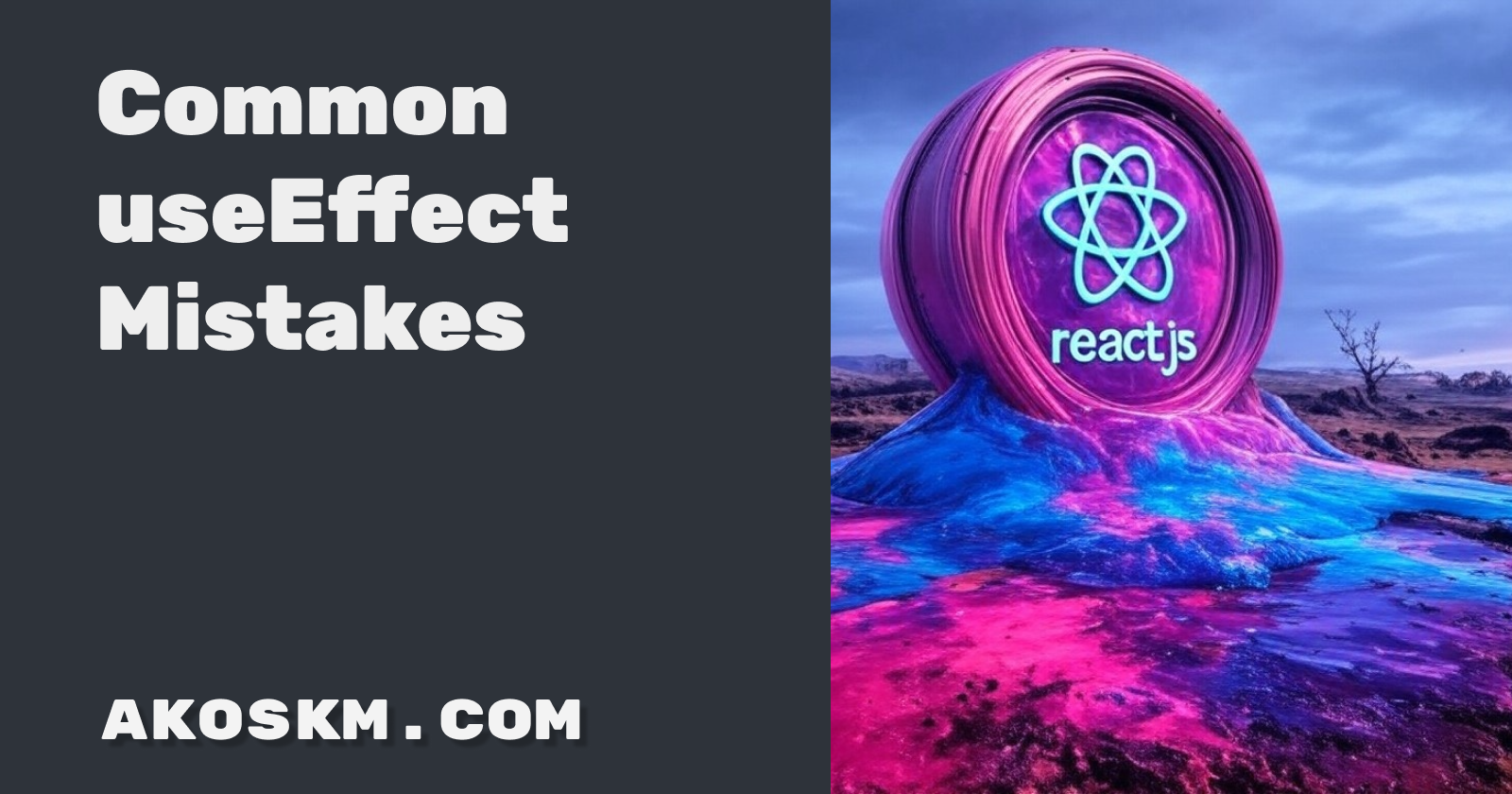Common useEffect Mistakes
 Ákos Kőműves
Ákos Kőműves
Learn how to avoid the most common mistakes when using useEffect.
What are the issues associated with useEffect?
Most issues I’ve had with using useEffect result from developers often mistaking it for a lifecycle function that runs when the component is first mounted.
Indeed, something like this can be achieved with a specific case of useEffect in which you leave the dependency array empty; it was not designed for this. Besides, leaving an empty dependency array can lead to weird behaviors in your app.
If you forget to specify dependencies, the effect will run after every render, which can cause performance issues or even infinite loops. If you include the wrong dependencies, it might not run as expected, leading to bugs that are hard to trace.
Instead, you should think about useEffect as an if-then, meaning:
useEffect(() => { // 2. run this
// SETUP CODE
const field = setUpField(player);
field.create();
// CLEANUP CODE
return () => {
field.destroy()
};
}, [player]); // 1. when this changes
Forget about mounting and unmounting.
Think of this as a setup that React re-runs when it sees fit.
You should also design the useEffect so the user can’t tell whether it runs once or more. This leads us to the next common mistake.
Cleanup
React will repeat your SETUP CODE and CLEANUP CODE multiple times during the component’s lifetime.
The cleanup function returned by the useEffect hook should clean up any connections you created, long-running calculations started, event listeners that were added, or anything else you did in your useEffect before repeating the setup code.
What goes into your CLEANUP code depends on what you did in SETUP CODE, which is why many developers entirely leave it out or struggle to write it correctly.
Single useEffect
One useEffect should always have one responsibility.
These hooks become difficult to read or maintain when you try to accomplish multiple unrelated things inside them.
useEffect(() => {
const connection = createConnection(serverUrl, roomId);
connection.connect();
const field = setUpField(player);
field.create();
// Cleanup function
return () => {
connection.disconnect()
field.destroy()
};
}, [roomId, player]);
The above useEffect will run on roomId or player update, but since the setup code is inside a single useEffect, you’ll set up a field for a player, even if only the roomId has changed.
Why is useEffect often bad practice?
Despite the above examples, useEffect is often used to fetch data. While this can be accomplished with the hook, there are a couple of downsides to this:
Lots of boilerplate code for
isLoadingand data settingDifficult to cache or preload data
If you’re using Server Components, you could be fetching them on the server instead
Waterfall-like rendering and loading spinner hell - you fetch data in a parent, but the child component relies on that data, so you display a loading spinner temporarily, and this goes on
Luckily, dedicated tools exist to solve this problem. You can simply perform the fetch inside your component if you’re using a framework that supports Server Components, such as Remix.
If you’re doing things in a SPA style, you can use TanStack Query.
What are the limitations of useEffect?
Synchronous Callback
The limitation people often run into is the callback not being async:
useEffect(() => { // sync callback
await // can't use await inside
}, []);
Which is a common problem if you’re using useEffect to fetch data. See the previous section of how you can do this better.
However, if you still want to go for the data-fetch inside useEffect and want to use async/await you can do it like this:
useEffect(() => {
async function fetchRoom() {
const response = await fetch(`${BASE_URL}/rooms/${roomId}`);
const roomData = await response.json();
if (!abort) {
setRoomName(roomData.name);
}
}
let abort = false;
fetchRoom(); // call the async function
return () => {
abort = true;
}
}, [roomId]);
Comparison
React uses Object.is to compare values with their previous values inside the dependency array. This can lead to all kind of limitations if you want to use non-primitive types inside the dependency array, such as arrays or objects:
useEffect(() => {
// you might have the same objects inside your rooms array, but the
}, [rooms]);
Check out this Codepen I made for you, but here’s what you need to know
const a = {};
const b = a;
console.log('{}, {}', Object.is({}, {})); // false
console.log('a, {}', Object.is(a, {})); // false
console.log('a, b', Object.is(a, b)); // true
const a1 = [a];
const a2 = [a];
console.log('array with same elements', Object.is(a1, a2)); // false
So basically, even if you’re having the same object (a and a) inside two different arrays, the array’s are different and will fail the equality check, causing the useEffect to rerun.
⚠️ Don’t do this
Unfortunately, a common theme I see in some React apps is simply stringifying the array and using the string version of it [JSON.stringify(rooms)] for the comparison. This is a much more common practice than it should be and indicates that you have a different problem to solve.
Does useEffect always cause a Rerender?
While useEffect itself doesn’t trigger a re-render, the operations you perform within it can indirectly cause re-renders.
For example, if you update the component’s state inside useEffect, it will trigger a re-render because state changes always lead to a new render cycle in React. Therefore, understanding how and when useEffect runs is crucial for avoiding performance bottlenecks by avoiding unnecessary re-renders in your application.
What causes useEffect to trigger?
When you pass a dependency array as the second argument to useEffect, it will only re-run the effect when one of the dependencies changes.
If you provide an empty array, the effect will only run once after the initial render, similar to componentDidMount in class components.
The official React documentation includes an interactive playground to see how useEffect behaves when passing an array of dependencies, an empty array, and no dependencies at all.
Conclusion
Here’s a recap of the most common mistakes I see with React developers using useEffect.
Avoid treating
useEffectas a lifecycle function; it's a conditional setup that React re-runs as needed.Ensure proper dependency management to prevent performance issues and infinite loops.
Keep each
useEffectfocused on a single responsibility for better readability and maintenance.Implement correct cleanup code to manage connections, calculations, and event listeners.
Use alternatives like Server Components or TanStack Query for data fetching to reduce boilerplate and improve performance.
Be cautious with non-primitive dependencies in the dependency array to avoid unnecessary re-runs.
Avoid improper practices like stringifying arrays for comparison, as it indicates a deeper problem.
Subscribe to my newsletter
Read articles from Ákos Kőműves directly inside your inbox. Subscribe to the newsletter, and don't miss out.
Written by

Ákos Kőműves
Ákos Kőműves
I build web apps and make educational content to help web developers.